“The budget and the economy bill are replete with folly and injustice. It is a tragedy that the moral energies and enthusiasm of many truly self-sacrificing and well wishing people should be so misdirected.”
John Maynard Keynes, Essays in Persuasion, “The Economy Bill, “19 September 1931 at page 145.
On 17 February Natural Resources Canada’s minister Jonathan Wilkinson led the release of an “interim” Sustainable Jobs Plan (ISJP),

Source: Government of Canada
The news release begins:
Canada has what it takes to be a clean energy and technology supplier of choice in a net-zero world….to secure and create jobs, to grow our industries, and to lead the world with the resources and technologies it will need for generations to come.
A chicken in every pot is proposed- “highly skilled and dedicated workers, abundant natural resources and energy sources critical for a net-zero future, and a thriving clean technology industry, Canada is uniquely positioned to seize the moment.” What is there not to like?
With historic investments in critical areas like critical minerals, hydrogen, carbon capture technologies, electric vehicles and more, the Government is positioning Canada for economic success in the years and decades to come. Central to this ambition is ensuring that workers in every region of this country have what they need to keep leading the way forward(emphasis added).
The “Interim Sustainable Jobs Plan was signed off by the federal Minister of Natural Resources, the Minister of Labour, and the Minister of Employment, Workforce Development and Disability Inclusion. Notable was any reference to the Minister of Environment and Climate Change, Stephen Guilbeault and his department in the news release. There was only two mention of the Environment Minister in the ISJP and only in the context of a task force reporting to the minister.

The interim nature of the plan means that Canada’s first Sustainable Jobs Action Plan (SJAP) will be developed over the next two year- read AFTER the next federal election and “will be developed … in close collaboration with provinces and territories, Indigenous partners, labour partners, industry, and other key partners.”
Naturally, or predictably, the federal government will “establish” yet another office- the Sustainable Jobs Secretariat and “create” a Sustainable Jobs Partnership Council. Are these jobs “sustainable” decent and well-paying the cynic might ask? Probably would be the answer.
But there is more! The ten-point plan also includes these “actions”
- Develop economic strategies through the Regional Energy and Resource Tables;
- Introduce a sustainable jobs stream under the Union Training and Innovation Program;
- Advance funding for skills development towards sustainable jobs;
- Promote Indigenous-led solutions and a National Benefits-Sharing Framework;
- Improve labour market data collection, tracking and analysis;
- Motivate investors and draw in industry leadership to support workers;
- Collaborate and lead on the global stage; and
- Establish legislation that ensures ongoing engagement and accountability.
Nowhere does the SJAP enumerate the needed sacrifices Canadian will have to make to safeguard the environment for “future generations.”
Let’s first examine “Motivate investors and draw in industry leadership to support workers.” What does this mean? Is it the job of investors and industry leaders to “support workers?” What universe are the authors of this press release living on? Perhaps the dirigiste world inhabited in the early phases of the European Union Coal and Steel Community in the 1950s and 1960s where grand visions of an interventionist Keynesian state could buttonhole industrialists with a vision of a unified common market to rebuild western Europe and to make future European wars extinct.
With the assault on the competence of the state beginning with Reagan and Thatcher, the Canadian state has no credibility today. For big business, the state has become something to manipulate through lobbying and, until recently, campaign financing to achieve their ends which have always been to maximize profits. Maximizing profits does not mean “support workers” unless there is a government quid pro quo such as generous tax benefits or grants to hire workers.
Investors meanwhile are increasingly short-term in focus as investment professionals, like investment bankers, focus on their next big bonus cheque. This means short-term “plays” or “trades” that will both result in big paydays as well as an improved ability to move up the ladder as a “superstar” investment manager. Sustainable investing could well be a good “play”, but timing is critical. This play has come under increasingly skepticism from industry professionals, former politicians and the sophisticated investors.
Like the London whale in 2012, traders and investment professionals have considerable room to develop specialized positions which internal controls miss leading to huge losses. Ottawa should not expect that in a mainly hyper-alpha male world of investment management that these professionals care about workers.
Testimony
Typical in these staged announcements are testimonials from affected or interested groups who wax fawningly about the government action. In this case we have the following cast of characters:
Patrick Campbell, Canadian Regional Director, International Union of Operating Engineers
Russ Shewchuk International Vice-President of the International Brotherhood of Electrical Workers (IBEW) First District, Canada
Bea Bruske, President of the Canadian Labour Congress
Pedro Barata, Executive Director, Future Skills Centre
Noticeably absent were spokespeople for either natural resources producers or environmental groups- the opposing poles in this evolving drama. Clearly, labour groups felt that “Ottawa” had their backs. Time will tell.
Embroidering the release were “Quick facts” including the federal government’s Investment Tax Credit for Carbon Capture, Utilization and Storage, the new Critical Mineral Exploration Tax Credit, Investment Tax Credits for Clean Hydrogen and Clean Technologies.
The full 32 page HTML document, like the press release, begins with soaring language about skilled hardworking people “to harness the opportunity of a net-zero future.” The first part of the document reads like an investment prospectus to convince both Canadians and foreign investors that Canada is the place to put their wealth to the best purpose.
Is this action?
Readers of this document may wish to suspend judgment about whether this document has much, if any, action in it- except spending commitments and promises of more from the Liberal government.
My reading is that most of this document is what some pundits, business persons, and academics might term “aspirational.” The language uses words like establish, collaborate, motivate, promote, advance fund, introduce, develop strategies and create new organizations. Such aspirations are unquantifiable in the main.
The interim plan tends to be all about talking while doing little concrete to address climate change and reduction of emissions.
Certainly the communications people (“poli-comms” ) had the final say over the document and its preparation.
Labour is central focus
From the discussion about previous consultations on this transition, just or otherwise, labour unions, notably Alberta labour unions had there views repeated. Both the AFL and the Alberta Union of Provincial Employees were quoted extensively.
“The AFL’s vision for transformative change includes significant federal transfers to the provinces so they can seize the “unprecedented infrastructure and commercial opportunity” of the clean energy transition.
The Alberta Union of Provincial Employees (AUPE) is seeking an explicit commitment within the just transition principles to support affected communities and individuals throughout the transition and that federal programming includes funding to create long-term economic opportunities.”
The report also noted that one of organized labour’s issues was “the prevalence of non-unionized workers in the oil and gas sector.”
Other consulted parties
At the back end of the report is a summary of two years of discussions about just transition/sustainable jobs. In this section there was an admission that “some provinces would like to see the federal government abandon plans for legislation.” The reason given for this according to federal comms. people is that a sustainable jobs initiative “would undermine the economic future and livelihoods of oil and gas workers by signaling the end of their industry.” Code for Alberta and Saskatchewan defending their key resource industry.
Principles
Defining principles give precedence to workers but also to local and regional “needs” along with a smorgasbord of aspirational goals like inclusivity, diversity, and community and cognizance of “enterprises” and “investors.”
Alberta’s response
Predictably Danielle Smith reacted releasing a with a statement on the federal ‘just transition’ plan at 3:40 Saturday afternoon, a day after the federal announcement. She expressed “puzzlement” with the “rebranded” sustainable jobs plan. Notable for Smith was the absence any mention of the role of Liquefied natural gas (LNG) as an export.
“our Government is perplexed by the blatant exclusion of any federal strategy to aggressively increase LNG exports to obtain emissions credits (under international agreements) for replacing higher emitting fuels around the world with Canadian LNG while simultaneously driving economic growth in Alberta and Canada.”
The Premier highlighted “the complete lack of recognition in the Plan for the provinces’ constitutional rights to develop our natural resources and to manage our labour workforce.” She stressed that “discussions” with provinces is not enough but requires “outright provincial approval and cooperation.” She goes on to argue that “(T)his kind of dysfunctional communication by the federal government with our province cannot continue if Canada is to have any chance of achieving its 2050 emissions reduction targets.”
Smith invites the federal government to the table “in good faith but warns “this continued pattern of unilateral federal action in areas of provincial jurisdiction must stop immediately.”
Alberta “remains alarmed” at the federal Emissions Reduction Plan (ERP), noting this “accelerated and arbitrary target is simply not viable or achievable without significant production cuts that will permanently devastate Alberta’s and Canada’s economy and freeze tens of billions in energy investment overnight” (emphasis added).
To make her point more emphatic she claims the ERP:
would be a policy package of economic destruction to the Alberta and Canadian economies unlike any previous federal policy in our province’s history. The federal government must walk back the ERP, oil and gas emissions cap and clean electricity regulation, and instead focus on collaborating with Alberta and other provinces in investing in the emerging clean technologies and LNG export strategy necessary to achieving net-zero emissions by 2050 (emphasis added).
Opinion
There are some who view recent correspondence from the Premier as conciliatory to Trudeau and Ottawa. There is some suggestion that these overtures to Ottawa show a more moderate approach to Ottawa. Judging from the direct quotes and not through media interpretation, it is very clear that the Premier is carefully preparing the groundwork for a battle royale with Ottawa. A battle which her statement suggests is more critical than the battle over the National Energy Policy. Here I agree with her. She is determined to challenge Ottawa’s constitutional capacity to reduce GHG emissions. Of particular irritation is any suggestion there should be a cap on emissions, suggesting Smith believes further expansion of the industry’s emissions is ok.
Pathways’ pitch
Emissions
Coincident with the ISJP came soft, “feel-good” advertising from the Pathways Alliance with full page ads in Postmedia outlets and the Globe and Mail with the claim “We’re making clear strides.” The ads continue
Oil sands operations contribute significant – carbon emissions in Canada- so the six largest companies are using several pathways to get to net-zero. We’ve teamed up to invest in technology and innovation as part of a robust plan.
Unfortunately the facts belie a naïve optimism that “technology and innovation” are the solution. On the same day that the ISJP was released (and the Rouleau report), Statistics Canada produced the Canadian System of Environmental–Economic Accounts: Energy use and greenhouse gas emissions, 2020. Included in the report was the statement:
The oil and gas extraction industry has also been the highest GHG-emitting industry from 2009 to 2020, responsible for 22.4% of Canada’s total GHG emissions in 2020. As shown in Chart 3, the oil and gas extraction industry has shown generalized growth in both GHG emissions and GDP from 2009 to 2020, except in 2016, 2019, and 2020. The most notable decrease occurred in 2020 due to the pandemic.
Source: Statistics Canada
The good news is that Canada’s GDP has been growing faster than GHG over the 2009-19 period (pre COVID). According to Statistics Canada, in 2020, gross domestic product (GDP) decreased 5.1%, while industrial GHG emissions saw an even greater decrease (-10.2%).
The main cause for the reduction relative to GDP growth is the shut down of the coal electricity generation facilities in Ontario and Alberta under the the Liberals and NDP respectively.
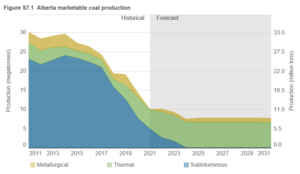
The coal electricity generators are doing their part in stemming the rise of GHG. But for the biggest fossil fuel GHG producers- oil and gas companies like the Big Four, they expect to continue their current emissions banking on “innovation and technology” to get to “net-zero” by 2050.
This pandering approach by the Liberal government and the Alberta government’s continuing sycophancy is folly and injustice. The industry has been making promises for years with their never-never plans of absolute reductions while continuing to expand their production.
The “emissions intensity” argument has become lame and tired as the industry’s and Alberta government’s “never-never plan” to handle environmental liabilities and reduce emissions are soothing words with actions are no different than the “action plans” of successive federal governments. 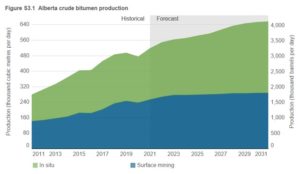
Source: Alberta Energy Regulator. Alberta Energy Outlook, May 2022.
Emissions
According to a July 2022 federal discussion paper oilsands production and emissions since 1990 emissions for oilsands mining, in-situ and upgrading grew from 133 barrels per annum and 15 megatonnes (MT) of GHG respectively to 1,078 million barrels and 81 MT in 2020. From 1990 production grew 8.1 times while emissions grew only by 5.4 times- hardly a triumph of technology and innovation.
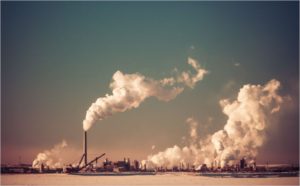
In reviewing the most recent sustainability, stewardship. or ESG reports of Imperial Oil, CNRL, Cenovus, and Suncor, emission reductions play a big role in promoting the carbon capture technologies beings worked on.
For Cenovus there is a lot of discussion about planned carbon capture projects at Christina Lake, the Lloydminster upgrader and undertaking engineering studies with projected numbers for sequestration. Since scope 3 emissions constitute upwards of 80 per cent of the emissions originating in its production facilities-
To achieve the goals of the Paris Agreement, society must address emissions across the value chain, from initial production to final consumption. Significant progress on reducing those emissions will require collaboration across sectors, academia, governments, researchers, entrepreneurs and others. We participate in a number of collaborative opportunities to find solutions to address emissions from the use of our products, such as the NRG‑COSIA Carbon X‑Prize which challenged teams to come up with useful products made from captured CO2, and CRIN, which has a mandate to focus on solutions for clean hydrocarbons from source to end use (emphasis added).
Strangely, Cenovus does not identify the oilsands industry as one of the principal parties to collaborate responsible for creating the scope 1, 2, and 3 emissions. Cenovus does report total scope 1 emissions of 23.1 MT down from 23.9 MT in 2019.
As with the other major players there are a lot of promises but little concrete evidence to give investors, citizens. and regulators comfort that emissions targets to 2030, let alone 2050, will be met.
Imperial Oil on the other hand provides a detailed table with specific date on emissions and energy consumption (p. 65) disclosing carbon dioxide, nitrous oxide, methane, sulphur oxides. and other recently broken down into about 30 categories. However there are no sub-totals which make it easier for the reader to see what total GHG, methane, etc. emissions are. The table provides data from 2017 to 2021 but It is unclear whether the number for 2021 are planned or actual.
There is further disclosure on emissions intensity and such things as R&D expenditures. One is left with the impression that some progress is being made in reducing emissions but there is scant evidence that innovation and technological breakthroughs have been produced at Imperial.
At CNRL, its reporting on emissions is in accordance with
GHG Protocol Corporate Accounting and Reporting Standard, Alberta Greenhouse Gas Quantification Methodologies (AQM) for individually regulated projects, Western Climate Initiative Essential Requirements for Mandatory Reporting and internal calculation guidance based on the AQM and supplemented with internal engineering estimates for methane emissions from unmetered sources.
Like Imperial, CNRL reports emissions intensity and emissions from 2017 to 2021 but at a less granular level. Scope 1 emissions have grown from 21.03 megatonnes in 2017 to 23.15 MT in 2021. Scope 2 emissions have grown marginally from 2.69 MT to 3.25 MT. Scope 3 emissions were not reported from 2017 to 2020. In 2021 they were calculated at 132 MT illustrating the profound nature of bitumen’s role in supporting millions of fossil fuel burning gas vehicles on the world’s highways.
For Suncor, the 2022 sustainability reports gives 21.6 MT as scope 1 emissions for 2021 and 28,5 MT in scope 1 and 2 emissions. The report observes that the company’s 2030 objective is to reduce its emissions by 10MT by 2030. The company, like its competitors in the Pathways Alliance, has declared a net-zero target by 2050. The company follows a practice of “continuous improvement” with respect to a variety of emissions including sulphur recovery, nitrogen oxides and sulphur dioxides.
Suncor also reports various emissions intensities over the past five years showing marginal improvements consistent with other companies. More breakthroughs not “continuous improvement” are required by the Big Four. Suncor also reported “engagement with suppliers” to reduce scope 3 emissions.
In the past few weeks under-reporting on methane emissions has been identified by a Carleton University engineering professor. Bob Weber’s article noted that methane emissions is often rated as 25 times more potent than carbon dioxide emissions. Companies typically measure methane emissions.
Industry generally relies on an estimate of how much methane comes to the surface for each barrel of oil, then multiplies that measurement by how much oil is produced. In recent years, several studies using direct measurement from overflying aircraft have thrown doubt on that method.
The study, conducted over 962 sites in Saskatchewan using the latest airborne technology, found those sites released 3.9 times as much methane as recorded in government inventories. Although the study did not fly over Alberta oilsands facilities, it does raise doubts about the validity of regulatory reporting.
Tailings
In addition to emissions rising, there is the emergent problems of tailings ponds.
The Alberta Energy Regulator (AER) requires all tailings ponds to “be ready to reclaim within ten years after a mine’s life ends (i.e., the year in which the mining of bitumen is completed for an AER-approved mine plan). It’s unclear what “ready to reclaim: after 10 years means. For most facilities this means 2060 or later- the “never-never plan.”
Detailed requirements fall under Directive 085 Fluid Tailings Management for Oil Sands Mining Projects .The 59-page document outlines an industry application process which considers each pond a unique case requiring applications by the operator. the approach requires regular inspections and audits and evaluates company performance on an annual basis requiring “progressive reclamation.”
According to Environmental Defense, from 1990 the total volume of fine fluid tailings has grown from about 300 million litres to an estimated 1.5 trillion litres in 2020. Their website currently estimates the tailings ponds contain 1.8 trillion litres of water.
“What gets measured gets managed” is an old business school saying.
In reviewing the most recent sustainability reports of Imperial Oil, CNRL, Cenovus, and Suncor, there are references to tailings but mainly from a regulatory point of view with no numbers available to investors to fully assess the liabilities the companies are building up.
In Suncor’s case, the report notes ” 1 surface reclaimed and 2 tailings ponds advancing to closure and 15% reduction in fluid tailings inventories at Base Plant since 2010.” This approach does not mention how many “surfaces” are to be reclaimed, the amount of tailings “in inventory” and the prospective cost and timetable to deal with all the surfaces.
In the case of CNRL, its tailings management is given an AAA rating from Towards Sustainable Mining Framework developed by the Mining Association of Canada. The rigour of the18-page rating protocol should be critically assessed. A word search of the protocol had no reference to tailings which raises questions about how scientific and objective this industry-led initiative turns out to be. Another section quotes favourable reviews from BMO Capital markets:=
Oil sands producers have led the pace of improvement in numerous ESG trends over the past decade including emissions intensity, fresh water and tailings, as well as social/governance progress in Indigenous engagement, health & safety and executive alignment.
Unlike Suncor, CNRL does not disclose the number of surfaces reclaimed but like Suncor there is no timeframe and cost. Great hope of course is placed on technology development.
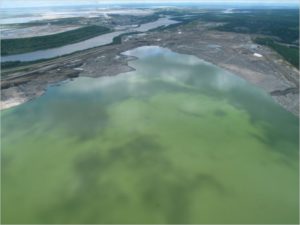
In the case of Cenovus, which is mainly an in-situ producer, the company has no tailings ponds adding ponds “are typically the larger methane sources in mining oil sands operations.”
For Imperial Oil, like the others, there is no measurement of the volumes in its tailings ponds but references to industry membership in Pathways Alliance and COSIA, Canada’s Oil Sands Innovation Alliance an “open source for innovation.”
In recent days Emma Graney of The Globe and Mail has reported the failure of Imperial Oil to keep the 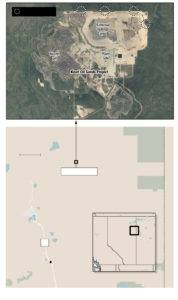 Athabasca Chipewyan First Nation abreast of developments concerning a May 2022 release of water tainted with arsenic and other toxic materials from its Kearl Lake tailings ponds. In the article, a spokesperson from the AER disavowed any responsibility of the regulator noting it was the licensee’s responsibility to inform “affected parties.” So much for environmental, social and governance best practices.
Athabasca Chipewyan First Nation abreast of developments concerning a May 2022 release of water tainted with arsenic and other toxic materials from its Kearl Lake tailings ponds. In the article, a spokesperson from the AER disavowed any responsibility of the regulator noting it was the licensee’s responsibility to inform “affected parties.” So much for environmental, social and governance best practices.
Much of the current debate on ESG reporting relates to the adequacy, comparability, and consistency of reporting along with fears over greenwashing. Like the federal initiatives on emissions, much ink and hot air is evident from emitters but significant absolute reductions have not been realized. The most charitable thing to say about the Big Four is that emissions have plateaued. Without federal and provincial governments mandating reductions, setting real emissions caps which can’t be dodged with offsets, Canada will continue to fail to meet its commitments.
Well meaning people intentions and plans to plan are sadly not enough As Keynes said nearly one-hundred years ago-“It is a tragedy that the moral energies and enthusiasm of many truly self-sacrificing and well wishing people should be so misdirected.”
Related Posts:
(MT)
